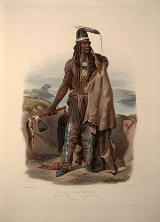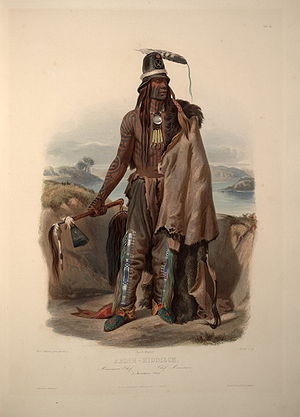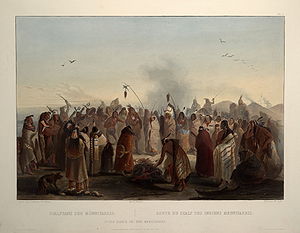
Hidatsa
Encyclopedia

Siouan languages
The Western Siouan languages, also called Siouan proper or simply Siouan, are a Native American language family of North America, and the second largest indigenous language family in North America, after Algonquian...
people, a part of the Three Affiliated Tribes
Mandan, Hidatsa, and Arikara Nation
Mandan, Hidatsa, and Arikara Nation, also known as the Three Affiliated Tribes, are a Native American group comprising a union of the Mandan, Hidatsa, and Arikara peoples, whose native lands ranged across the Missouri River basin in the Dakotas...
. The Hidatsa's autonym is Hiraacá. According to the tribal tradition, the word hiraacá derives from the word "willow
Willow
Willows, sallows, and osiers form the genus Salix, around 400 species of deciduous trees and shrubs, found primarily on moist soils in cold and temperate regions of the Northern Hemisphere...
"; however, the etymology is not transparent and the similarity to mirahací ‘willows’ inconclusive. The present name Hidatsa was formerly borne by one of the three tribal villages. When the villages consolidated, the name was adopted for the tribe as a whole. Their language
Hidatsa language
Hidatsa is an endangered Siouan language, closely related to the Crow language. It is spoken by the Hidatsa tribe, primarily in North Dakota and South Dakota....
is related to that of the Crow
Crow Nation
The Crow, also called the Absaroka or Apsáalooke, are a Siouan people of Native Americans who historically lived in the Yellowstone River valley, which extends from present-day Wyoming, through Montana and into North Dakota. They now live on a reservation south of Billings, Montana and in several...
, and they are sometimes considered a parent tribe to the modern Crow in Montana
Montana
Montana is a state in the Western United States. The western third of Montana contains numerous mountain ranges. Smaller, "island ranges" are found in the central third of the state, for a total of 77 named ranges of the Rocky Mountains. This geographical fact is reflected in the state's name,...
. Occasionally they have also been confused with the Gros Ventres
Gros Ventres
The Gros Ventre people , also known as the A'ani, A'aninin, Haaninin, and Atsina, are a historically Algonquian-speaking Native American tribe located in north central Montana...
in Montana.
Accounts of recorded history in the early 18th century identify three closely related village groups to which the term Hidatsa is applied. What is now known as the Hidatsa tribe is the amalgamation of these three groups: the Hidatsa proper, the Awatixa, and the Awaxawi (or Amahami) (Bowers 1965). These groups had discrete histories and spoke different dialects; they came together only after settling on the Missouri River
Missouri River
The Missouri River flows through the central United States, and is a tributary of the Mississippi River. It is the longest river in North America and drains the third largest area, though only the thirteenth largest by discharge. The Missouri's watershed encompasses most of the American Great...
.
The Amahami have a creation tradition similar to that of the Mandan, which describes their emergence long ago from the Earth, at Devil's Lake. Later they moved westward to the Painted Woods (near Square Buttes) and settled near a village of Mandan and another of Awatixa.
The Awatixa originated not from the earth, but from the sky, led by Charred Body (Wood and Hanson 1986:34). According to their tradition, their first people lived near Painted Woods, "where they were created" (Bowers 1948:17-18). After that they always lived between the Heart and Knife Rivers along the Missouri.
The Hidatsa proper, largest of the three, were initially part of those who would become the River Crow. They separated from the Amahami in what is now western Minnesota. First they settled to the north, then later moved south to Devil's Lake. In their travels they met the Mandans and then moved westward and settled with these distant relatives north of the Knife River. Later they moved to the mouth of Knife River.
The Hidatsa originally lived in Miniwakan, the Devil's Lake
Devil's Lake (North Dakota)
Devils Lake is a lake in the U.S. state of North Dakota. It is the largest natural body of water and the second-largest body of water in North Dakota after the artificially created Lake Sakakawea. In 2011, it reached an unofficial historical high elevation of 1454.20 feet. Additional rises above...
region of North Dakota, before being pushed southwestward by the Lakota. As they migrated west, the Hidatsa came across the Mandan at the mouth of the Heart River
Heart River
The Heart River is a tributary of the Missouri River, approximately 180 mi long, in western North Dakota in the United States.-Course:...
. The two groups formed an alliance, and settled into an amiable division of territory along the area's rivers.
In 1804, Lewis and Clark
Lewis and Clark Expedition
The Lewis and Clark Expedition, or ″Corps of Discovery Expedition" was the first transcontinental expedition to the Pacific Coast by the United States. Commissioned by President Thomas Jefferson and led by two Virginia-born veterans of Indian wars in the Ohio Valley, Meriwether Lewis and William...
came to the Hidatsa in three villages at the mouth of the Knife River
Knife River
This article is about the river in North Dakota. For other meanings, see Knife River The Knife River is a tributary of the Missouri River, approximately 120 mi long, in North Dakota in the United States....
, and the Mandan in two villages a few miles lower down on the Missouri River. Tribal appearance and customs have been documented by the visits of two artists of the American west. The allied tribes were first visited by American George Catlin
George Catlin
George Catlin was an American painter, author and traveler who specialized in portraits of Native Americans in the Old West.-Early years:...
, who remained with them several months in 1832. He was followed by Karl Bodmer
Karl Bodmer
Karl Bodmer was a Swiss painter of the American West. He accompanied German explorer Maximilian zu Wied-Neuwied from 1832 through 1834 on his Missouri River expedition...
, a Swiss painter
Painting
Painting is the practice of applying paint, pigment, color or other medium to a surface . The application of the medium is commonly applied to the base with a brush but other objects can be used. In art, the term painting describes both the act and the result of the action. However, painting is...
accompanying German
Germans
The Germans are a Germanic ethnic group native to Central Europe. The English term Germans has referred to the German-speaking population of the Holy Roman Empire since the Late Middle Ages....
explorer Maximilian zu Wied-Neuwied
Prince Maximilian of Wied-Neuwied
Prince Alexander Philipp Maximilian zu Wied-Neuwied was a German explorer, ethnologist and naturalist....
on a Missouri River expedition from 1832 to 1834. Catlin and Bodmer's works record the Hidatsa and Mandan societies, where were rapidly changing under pressure from encroaching settlers, infectious disease, and government restraints.

Smallpox
Smallpox was an infectious disease unique to humans, caused by either of two virus variants, Variola major and Variola minor. The disease is also known by the Latin names Variola or Variola vera, which is a derivative of the Latin varius, meaning "spotted", or varus, meaning "pimple"...
epidemic
Epidemic
In epidemiology, an epidemic , occurs when new cases of a certain disease, in a given human population, and during a given period, substantially exceed what is expected based on recent experience...
of 1837-1838 reduced the Hidatsa to about 500 people. The remaining Mandan and Hidatsa united, and moved farther up the Missouri in 1845. They eventually settled at "Like-a-fishhook" bend near Fort Berthold. They were joined there by the Arikara
Arikara
Arikara are a group of Native Americans in North Dakota...
in 1862.
The Hidatsa are a matrilineal
Matrilineality
Matrilineality is a system in which descent is traced through the mother and maternal ancestors. Matrilineality is also a societal system in which one belongs to one's matriline or mother's lineage, which can involve the inheritance of property and/or titles.A matriline is a line of descent from a...
people, with descent determined through the maternal line. As the early Mandan and Hidatsa heavily intermarried, children were taught to speak the language of their mother, but understand the dialect of either tribe. A short description of Hidatsa-Mandan culture, including a grammar and vocabulary of the Hidatsa language, was published in 1877 by Washington Matthews
Washington Matthews
Washington Matthews was a surgeon in the United States Army, ethnographer, and linguist known for his studies of Native American peoples, especially the Navajo.-Early life and education:...
, a government physician assigned to the Fort Berthold Indian Reservation.
During the early twentieth century, Gilbert Livingston Wilson
Gilbert Livingston Wilson
Gilbert Livingston Wilson was an ethnographer and a Presbyterian minister. He and his brother recorded the lives of three Hidatsa family members; Buffalo-Bird-Woman, her brother Henry Wolf Chief, and her son Edward Goodbird...
carried out extensive ethnographic work with the elderly Hidatsa woman, Buffalo Bird Woman
Buffalo Bird Woman
Buffalo Bird Woman was a Mandan ]Hidatsa who experienced the traditional life of her people in what is now the Fort Berthold Reservation in North Dakota. Her Hidatsa name was Maxidiwiac. She learned and practiced traditional Hidatsa skills such as gardening, the preparation of food, weaving and...
. He also interviewed members of her immediate family at Fort Berthold. From his information gathered from them, Wilson described traditional economy, ceremony, and day-to-day practices as remembered by Buffalo-Bird Woman, who lived at Like-a-Fishhook Village.
See also
- Historians Gerald W. WolffGerald W. WolffGerald W. Wolff is professor emeritus at the University of South Dakota, known for his specialization in the history of Native Americans, the American West, and national politics.-Background:...
and Joseph H. Cash collaborated on studies of six tribes, the Hidatsa, the Arikaras, the Mandans, the PoncasPonca Tribe of Indians of OklahomaThe Ponca Tribe of Indians of Oklahoma, also known as the Ponca Nation, is a federally recognized tribe located in Oklahoma. The Ponca traditionally speak the Omaha-Ponca language, part of the Souian language family. Another portion of the people belong to the larger Ponca Tribe of...
, the OttawaOdawa peopleThe Odawa or Ottawa, said to mean "traders," are a Native American and First Nations people. They are one of the Anishinaabeg, related to but distinct from the Ojibwe nation. Their original homelands are located on Manitoulin Island, near the northern shores of Lake Huron, on the Bruce Peninsula in...
s, and the ComancheComancheThe Comanche are a Native American ethnic group whose historic range consisted of present-day eastern New Mexico, southern Colorado, northeastern Arizona, southern Kansas, all of Oklahoma, and most of northwest Texas. Historically, the Comanches were hunter-gatherers, with a typical Plains Indian...
of TexasTexasTexas is the second largest U.S. state by both area and population, and the largest state by area in the contiguous United States.The name, based on the Caddo word "Tejas" meaning "friends" or "allies", was applied by the Spanish to the Caddo themselves and to the region of their settlement in...
. - Knife River Indian Villages National Historic SiteKnife River Indian Villages National Historic SiteThe Knife River Indian Villages National Historic Site, which was established in 1974, preserves the historic and archaeological remnants of the Northern Plains Indians. This area was a major trading and agricultural area. There were three villages that occupied the Knife area. In general, these...
- Knife River: Early Village Life on the Plains, a National Park Service Teaching with Historic Places (TwHP) lesson plan
- Buffalo Bird Woman's Garden, As Recounted by Maxi'diwiac (Buffalo Bird Woman) (ca.1839-1932) of the Hidatsa Indian Tribe, Originally published as Agriculture of the Hidatsa Indians: An Indian Interpretation, by Gilbert Livingstone Wilson
- Minnesota State Historical Society Inventory of G.L. and F.N. Wilson’s Papers
- White Buffalo Cow SocietyWhite Buffalo Cow SocietyThe White Buffalo Cow Society was the most respected women's society amongst the Mandan and Hidatsa tribal peoples, equaled in the importance by the Bull Society amongst the men. The women of the White Buffalo Cow Society performed the buffalo-calling ceremony during the winter.-Origin:The White...
External links
- Mandan, Hidatsa, and Arikara Nation, official website

